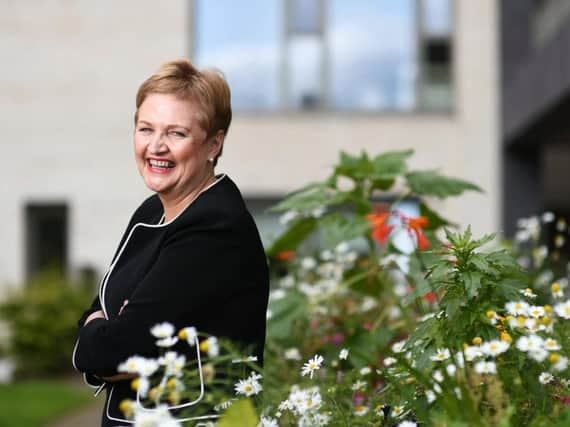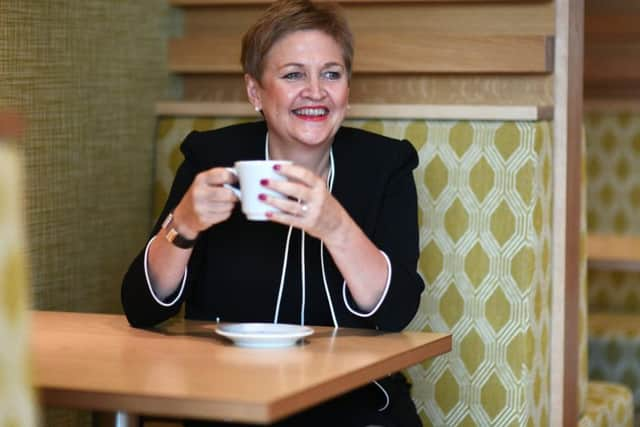The Big Interview: The Prince & Princess of Wales Hospice CEO Rhona Baillie


The launch was a highly emotional moment for the organisation’s chief executive Rhona Baillie, who had been at the forefront of the major undertaking that was several years, conversations and contracts in the making – and included the raising of some £21 million to bring the vision to life.
The new building also marked a move from the organisation’s previous location dating back more than 30 years – in Carlton Place on the banks of the Clyde – the concept of a modern hospice in Glasgow having been originated by the late Anne Gilmore, a GP.
Advertisement
Hide AdAdvertisement
Hide AdIn 1980, staff at Black & White Whisky presented Gilmore with £4,000, a charitable trust was set up, and it was decided by Glasgow’s then Lord Provost Michael Kelly to make the hospice a wedding gift to Charles and Diana from the people of the city in 1981.


The following year, comedian Billy Connolly cycled from London to Glasgow to publicise the hospice as part of ongoing fundraising efforts, while the royal couple for whom it was named visited in 1990.
Legacy
Baillie is justifiably extremely proud of the project, which she says is a career highlight and a wonderful legacy to leave Glasgow. “I still every day come in and think ‘oh my goodness, look what we did’ – and I hope that we always all feel like that.”
The hospice has 160 staff, 760 volunteers, some of whom work in its shops, and 1,200 new patients are referred to it every year – with the cost of looking after such patients, their carers, and their families amounting to £5m a year, with £1.9m coming from the NHS and the hospice’s fundraising and events team needing to generate the shortfall.
Its corporate benefactors include Irn-Bru maker AG Barr, Slaters Menswear and car dealership group Lookers – while Hospice UK, the national charity for hospice and palliative care, says that in Scotland, hospices receive on average 38 per cent of their income from the government, compared to 34 per cent in Northern Ireland, 33 per cent in England, and 28 per cent in Wales.
It also found that collectively, charitable hospices in the UK need to raise more than £1 billion a year from fundraising – equivalent to £2.8m a day.
For senior healthcare director Baillie, PPWH harnesses the skills developed throughout her career, having a long history of redesigning healthcare models and a special interest and education background in cancer and palliative care.
But it was a job early on in her working life that proved to be surprisingly educational. She started out taking up a post with Bank of Scotland in Glasgow, but soon discovered that it wasn’t the best fit for her skillset. “I understand figures but don’t really like a spreadsheet – a cloud comes over my head,” she laughs.
Advertisement
Hide AdAdvertisement
Hide AdWhen the chip shop in East Kilbride where she had previously worked part-time heard she wanted to give up the day job in finance, they offered her a full-time post that she accepted. Her parents weren’t too keen on her saying goodbye to what they saw as a “good, stable” career – and she wishes they could see what she has now achieved.
Having swapped a banking counter for a fish and chip shop’s, she stayed at the latter for about two years. “I learned a lot from that job, because [it taught me] really good mental arithmetic, good customer service skills, and actually I was very, very happy in that role.”
Career switch
But she then decided she wanted to move into nursing, and trained at the Victoria Infirmary on the southside of Glasgow, instantly realising that it was her vocation.
After a few years, she wanted to train as a registered nurse in Canada, which she did, relocating to Toronto – with her passion for cancer/palliative care growing.
She returned to the UK, and in 1995 graduated from the University of Glasgow with a postgraduate degree in cancer nursing. She then approached PPWH with a view to being a community clinical nurse specialist – but was turned down for the “very good” reason of her lack of on-the-ground experience.
They pointed her in the direction of doing a BSc in community health at Glasgow Caledonian University, and after adding that string to her bow, she worked as a district nurse in the east end of Glasgow for roughly a year, and then moved into hospice work.
“I absolutely loved working with the people – they all had a life-limiting illness but I really, really enjoyed getting that really close relationship with patients and their families in their home. I found that absolutely was my niche – and to this day really still is.”
The next step was working in St Andrew’s Hospice in Airdrie, and then returning to the NHS, securing Cancer in Scotland funding, and developing a service to support terminally ill patients who wanted to die at home – with the project receiving a special commendation from the Scottish Parliament.
Advertisement
Hide AdAdvertisement
Hide AdShe was then seconded to the Scottish Executive Centre for Change and Innovation as a national facilitator in the cancer service improvement programme – including working on the target for 95 per cent of those referred urgently with a suspicion of cancer to begin treatment within 62 days of receipt of referral.
That was the job that “really built my backbone,” she says. Baillie then came to the attention of the head of PPWH, eventually taking on its director of clinical services post, and happy to focus on that side of its activity.
But she soon found herself assuming the chief executive role on an interim basis – finding she loved its duties that capitalised on her numerical, leadership and management skills. More crucially, she could always “be very close to the patient and family, and influence the quality of care”.
Baillie was officially made CEO in 2008 and oversaw a new strategy for the hospice to care for anyone with a life-limiting illness.
She had also noted that the previous site – townhouses that had been donated by Glasgow City Council – would not be suitable for future care. It was then decided that a new building was required, and while such a plan was launched in the wake of the financial crisis, Baillie was steadfast in her belief that it was the correct course of action.
Determination
“Many, many people asked me ‘why now’ – and the answer always was because terminal illness won’t wait, and actually the patients need a new environment.”
The Brick by Brick appeal was launched in 2012, with Alastair Forbes of Ryder Architecture signed up to realise the vision for the site, having been deemed a great fit for the project despite a lack of healthcare experience. Forbes was also asked to lie down in one of the hospice’s existing rooms for an hour to get a patient’s perspective.
“He said it changed his life in regards to his professional practice… he says it always reminds him that people are not service users… these are real people who are having real experiences.”
Advertisement
Hide AdAdvertisement
Hide AdThe new site adopted the Scandinavian Sengetun model of care that puts patients and families first, while Baillie singles out former Scottish Enterprise boss Jack Perry and Weir Group chairman Charles Berry as being “instrumental” in helping deliver the project. “We never, ever thought we could do this on our own.”
In May last year the £21m target was reached, with the fundraising strategy having been a global effort with the approach renewed every three months. The hospice’s board of directors boasts names such as Ronnie Bowie, a senior partner at actuarial consultancy Hymans Robertson, and David K Hunter, a founding partner of chartered accountant Campbell Dallas.
And Baillie – a past chairman of the Scottish Hospice Forum, former member of the council of the Scottish Partnership for Palliative Care, and now a member of Glasgow Chamber of Commerce Council – is now looking to step up the hospice’s contribution to the community, for example working to tackle social isolation and helping young people.
She cites a tie-up with a college that has brought about a beauty shop that trains students and generates income for the hospice. “There are quite a few social enterprise models that actually care for the communities without it being hands-on care for an illness that they might have. That’s a big focus for us.”
She is also working hard to ensure the hospice is in the best shape possible before the time comes to eventually hand over the reins. While the facility is still in a period of transition, “the care that we can deliver from this building is really exciting for us. We really feel that it offers us so many opportunities. It’s a very exciting future for us.”